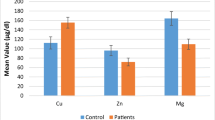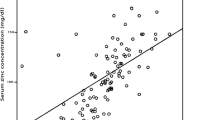Abstract
The purpose of the present study was to evaluate the status of serum trace elements: zinc, copper, manganese, iron, calcium, and magnesium concentrations in obsessive–compulsive disorder patients. Forty-eight obsessive–compulsive disorder patients and 48 healthy volunteers were included in this study. Patients were recruited from Bangabandhu Sheikh Mujib Medical University by random sampling. Serum trace element concentrations were determined using flame atomic absorption spectroscopy (for zinc, copper, iron, calcium, and magnesium) as well as graphite furnace atomic absorption spectroscopy (for manganese). Data were analyzed using independent t test, Pearson's correlation analysis, regression analysis, and ANOVA. Statistical analysis of these data showed a definite pattern of variation among certain elements in patients with obsessive–compulsive disorder compared to controls. In patients' serum, zinc, iron, and magnesium concentrations decreased significantly (p < 0.05) compared to the controls. Serum manganese and calcium concentrations were significantly higher (p < 0.05) in patients compared to the controls. These data showed a definite imbalance in the interelement relations in obsessive–compulsive disorder patients compared to controls and therefore suggest a disturbance in the element homeostasis.

Similar content being viewed by others
References
Siklar Z, Tuna C, Dallar Y, Tanyer G (2003) Zinc deficiency: a contributing factor of short stature in growth hormone deficient children. J Trop Pediatr 49(3):187–188
Zemel BS, Kawchak DA, Fung EB, Ohene-Frempong K, Stallings VA (2002) Effect of zinc supplementation on growth and body composition in children with sickle cell disease. Am J Clin Nutr 75:300–307
Zimowska W, Girardean J, Kuryszko J, Bayla D, Rayssiginer Y, Mazur A (2002) Morphological and immune response alterations in the intestinal mucosa of the mouse after short periods on a low magnessium diet. Br J Nutr 88(5):515–522
Hallberg L, Sandestrom B, Ralph A, Arthur J (2000) Iron, zinc and other trace elements. In: Garrow JS, James WPT, Ralph A (eds) Human nutrition and dietetics, 10th edn. Harcourt Publishers Ltd., Churchill Livingstone, pp 177–210
Percival SS (1998) Copper and immunity. Am J Clin Nutr 67(5):1064–1068
Shankar AH, Prasad AS (1998) Zinc and immune function: the biological basis of altered resistance to infection. Am J Clin Nutr 68(2l):447–463
Strong MJ, Garruto RM (1994) Experimental paradigms of motor neuron degeneration. In: Woodruff ML, Nonneman AJ (eds) Toxin-induced models of neurological disorders. Plenum, New York, pp 39–88
Garruto RM, Flaten TP, Wakayama I (1993) Natural and experimental models of environmentally induced neurodegeneration: implication for Alzheimer's disease. In: Corain B, Wisneiwski H, Zatta P (eds) Alzheimer's disease: advances in clinical and basic research. Wiley, New York, pp 257–266
Gotz MRE, Double K, Gerlach M, Youdim MB, Riederer P (2004) The relevance of iron in the pathogenesis of Parkinson's disease. Ann NY Acad Sci 1012:193–208
Richardson DR (2004) Novel chelators for central nervous system disorders that involve alterations in the metabolism of iron and other metal ions. Ann NY Acad Sci 1012:326–341
Zecca L, Stroppolo A, Gatti A et al (2004) The role of iron and copper molecules in the neuronal vulnerability of locus coeruleus and substantia nigra during aging. Proc Natl Acad Sci USA 101:9843–9848
Lai BC, Marion SA, Teschke K, Tsui JK (2002) Occupational and environmental risk factors for Parkinson's disease. Parkinsonism Relat Disord 8:297–309
Ozdemir E, Cetinkaya S, Ersan S, Kucukosman S, Ersan EE (2009) Serum selenium and plasma malondialdehyde levels and antioxidant enzyme activities in patients with obsessive–compulsive disorder. Prog Neuro Psychopharmacol Biol Psychiatry 33:62–65
American Psychiatric Association (2000) Diagnostic and statistical manual of mental disorders, text revised (DSM-IV-TR), 4th edn. American Psychiatric Press, Washington DC
Goodman WK, Price LH, Rasmussen SA, Mazure C, Fleischmann RL, Hill CL, Heninger GR, Charney DS (1989) The Yale-Brown obsessive compulsive scale I. development, use, and reliability. Arch Gen Psychiatry 46(11):1006–1011
NCCLS (1997) Control of pre-analytical variation in trace element determination. Nat Committ Clin Lab Stand Appr Guid 17:1–30
Czupryn M, Falchuk KH, Stankiewicz A, Vallee BL (1993) A Euglena gracilis zinc endonuclease. Biochem 32(5):1204–1211
Christensen JM, Kristiansen J (1994) Lead. In: Seiler HG, Siegel A, Sigel H (eds) Handbook on metals in clinical and analytical chemistry. Marcel Dekker, New York, pp 217–667
Muniz CS, Marchante-Gayon JM, Alonso JIG, Sanz-Medl A (1999) Multi-elemental trace analysis of human serum by double-focussing ICP-MS. J Anal Atomic Spectr 14:193–198
Murphy TK, Sajid MW, Goodman WK (2006) Immunology of obsessive–compulsive disorder. Psychiatr Clin North Am 29:445–469
Linter CM (1985) Neuropsychiatric aspects of trace elements. Br J Hosp Med 34:361–365
Ersan S, Bakır S, Erdal Ersan E, Dogan O (2006) Examination of free radical metabolism and antioxidant defence system elements in patients with obsessive–compulsive disorder. Prog Neuro-Psychopharmacol Biol Psychiatry 30:1039–1042
Iyengar GV (1989) Elemental analysis of biological system, vol 1. CRC, Boca Raton, p 242
Michiels C, Raes M, Toussaint O, Remacle J (1994) Importance of SE-glutathione peroxidase, catalase, and CU/ZN-SOD for cell survival against oxidative stress. Free Radical Biol Med 17(3):235–24
Bettger WJ, O'Dell BL (1981) A critical physiological role of zinc in structure and function of biomembranes. Life Sci 28:1425–1438
Vural H, Demirin H, Kara Y, Eren I, Delibas N (2010) Alterations of plasma magnesium, copper, zinc, iron and selenium concentrations and some related erythrocyte antioxidant enzyme activities in patients with Alzheimer's disease. J Trace Elem Med Biol 24:169–173
Nahar Z, Azad MAK, Rahman MA (2010) Zinc, magnesium, calcium, copper and manganese level in serum samples of panic disorder patients. Biol Trace Elem Res 133(3):284–290
Mustak MS, Rao TSS, Shanmugavelu P, Sundar NMS, Menon RB, Rao RV, Rao KSJ (2008) Assessment of serum macro and trace element homeostasis and the complexity of inter-element relations in bipolar mood disorders. Clin Chim Acta 294:47–83
Rajan MT, Rao KSJ, Mamatha BM, Rao RV, Shanmugavelu P, Menon RB, Pavithran MV (1997) Quantification of trace elements in normal human brain by inductively coupled plasma atomic emission spectrometry. J Neurol Sci 146:153–166
Rao KSJ, Rao RV, Shanmugavelu P, Menon RB (1999) Trace elements in Alzheimer's disease brain: a new hypothesis. Alzheimer's Rep 2:241–246
van Rensburg SJ, Potocnik FC, Kiss T et al (2001) Serum concentrations of some metals and steroids in patients with chronic fatigue syndrome with reference to neurological and cognitive abnormalities. Brain Res Bull 55:319–325
Acknowledgments
The authors thank all the participants of this study. The authors also thank the staffs of the Department of Psychiatry, Bangabandhu Sheikh Mujib Medical University (BSMMU), Dhaka, Bangladesh, for their technical and administrative support.
Conflict of Interest
None.
Author information
Authors and Affiliations
Corresponding author
Rights and permissions
About this article
Cite this article
Shohag, H., Ullah, A., Qusar, S. et al. Alterations of Serum Zinc, Copper, Manganese, Iron, Calcium, and Magnesium Concentrations and the Complexity of Interelement Relations in Patients with Obsessive–Compulsive Disorder. Biol Trace Elem Res 148, 275–280 (2012). https://doi.org/10.1007/s12011-012-9371-3
Received:
Accepted:
Published:
Issue Date:
DOI: https://doi.org/10.1007/s12011-012-9371-3




